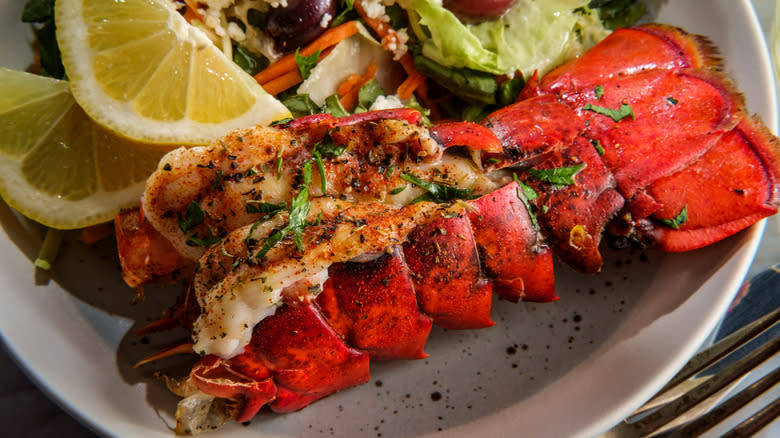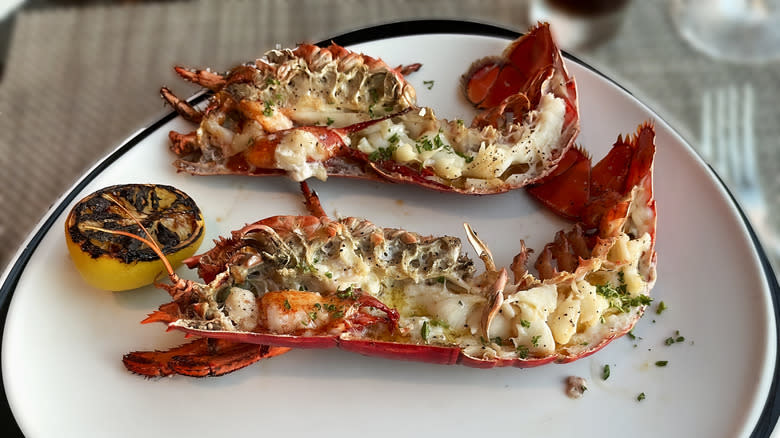Smoke That Lobster And Become The Star Of Your Next Cookout

A backyard barbecue is a fine tradition, the highlight of summer gatherings everywhere. There are all sorts of things to know about grilling and smoking, from the trick to use if your charcoal won't stay lit to how often you should be cleaning your grill. But while steaks, brisket, mushrooms, shrimp, and chicken may be classic meats to throw on a grill or in a smoker, sometimes you just want to try something new, something unexpected. And what could be more unexpected than smoking a lobster? It might seem strange, as the most classic way to cook a lobster is to steam or boil it. Maybe you've heard of butter-poached lobster, but smoking it is just as great.
Your first test here is picking a lobster. While frozen lobster is perfectly acceptable if you're just smoking the tails, if you're making a whole lobster, you definitely want a live one. And you might think bigger is better -- but that's where you're wrong. It's true that larger lobsters have more meat and can look more impressive to your guests, but if you're going for quality over visual appeal, you actually want a smaller one. Larger lobsters tend to be older, and older lobsters have tougher meat with a more fishy taste. Younger lobster, meanwhile, is not only generally more tender but sweeter. You also want to go for the more active lobsters in the tank and avoid any with a particularly bad smell.
Read more: 12 Underrated Types Of Fish You Should Try At Least Once
The Process Is Different With Tails Than Whole Lobster

Picking which part of the lobster to smoke is equally important. Though most online recipes will suggest smoking lobster tails, you don't need to feel limited by that; smoking a whole lobster can turn out great as long as you prepare it correctly and treat it right. But it's important to note the process differs between smoking a whole crustacean or just the tails.
If you're just smoking a lobster tail, use a pair of kitchen shears to cut lengthwise down the top of the shell, then gently pull the meat through without fully separating it from the shell at the base of the fin. You'll also want to insert a skewer lengthwise to keep the tail from curling up as it cooks.
If you're smoking a whole lobster, you want to parboil it first, just enough to separate it from the shell and ensure the entire thing cooks evenly. Boiling the claws for an extra couple of minutes by hooking the lobster over the edge of the pot with the curled tail (not a problem in this case) is also not a bad idea, as the claws take a little longer to cook. Make sure you blanche it in ice water to stop the cooking process, then separate it in half before smoking. This ensures the maximum amount of meat will be exposed to the smoke, imbuing the most flavor possible.
Other Tips For Smoking Lobster

As far as which wood chips to use, that's really up to you -- most varieties will work with smoking lobster. Apple and cherry are favorites for their mild sweetness that plays well off the flavor of the shellfish, but they're hardly your only options. Do be aware that if you use hickory, mesquite, or oak, it tends to impart stronger, earthier flavors. If this is too much for lobster, consider using pecan instead, which is essentially a far less overpowering version of hickory.
From there, both grill and smoker methods take around the same time: About 45 minutes at 200 to 225 degrees, aiming for around 135 to 140 degrees Fahrenheit. This may seem fast for smoking, which can often take hours, but seafood generally cooks quickly, and you don't want to overcook the lobster and turn it tough. Visually, you can tell when they're done, just like any other lobster: They should no longer be translucent. At that point, all you need to do is finish with the classic lobster accompaniments of butter and lemon, and you're good to go!
Read the original article on The Daily Meal.


